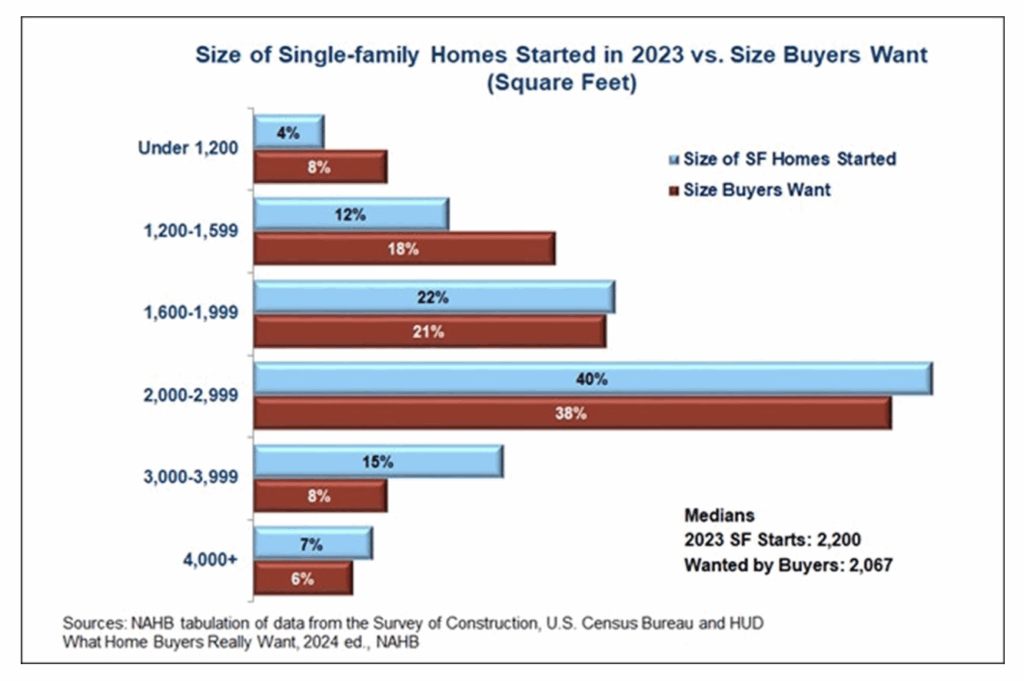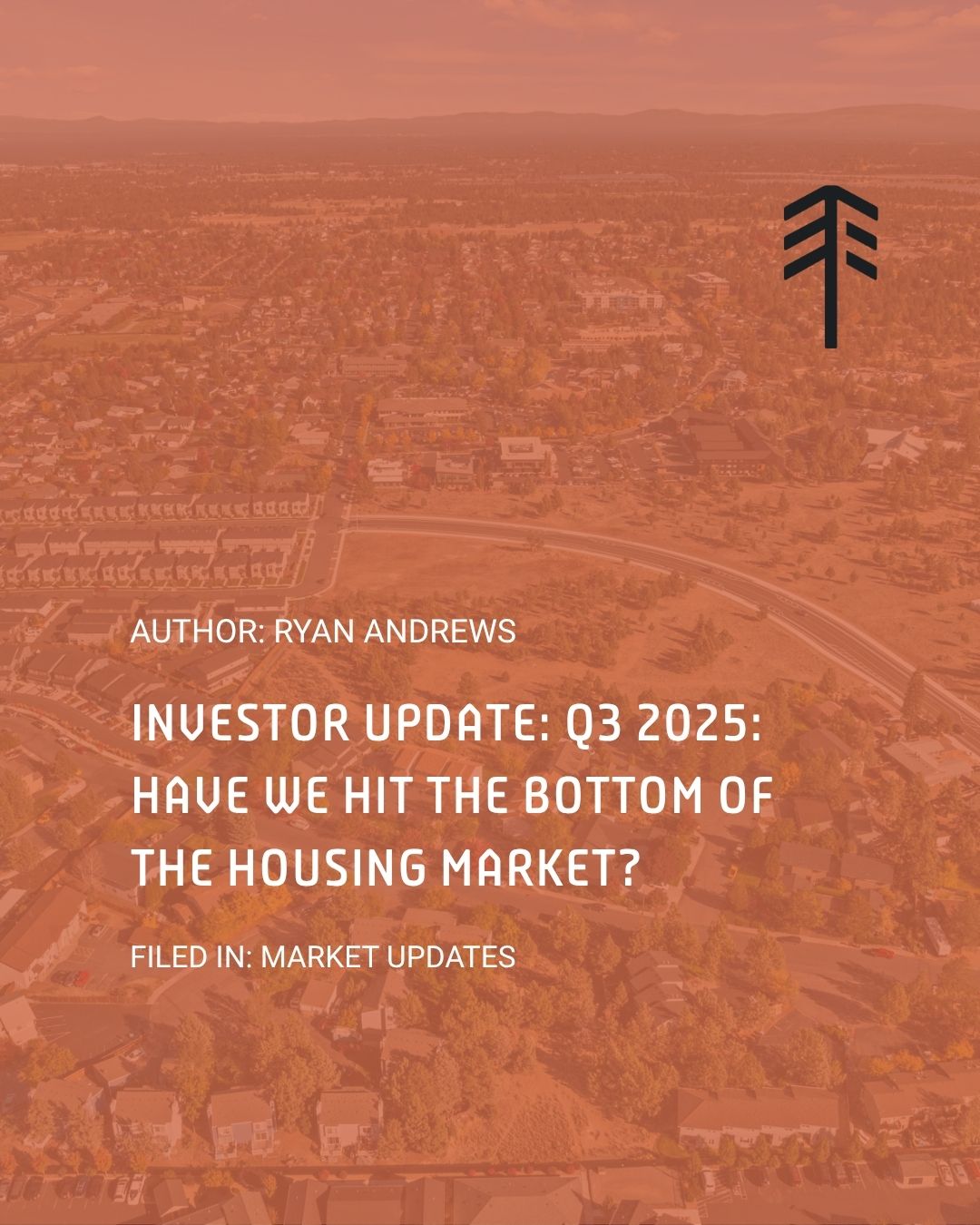A recent Fortune article laments what it calls housing “shrinkflation”… the fact that new homes are 11% smaller than a decade ago while costing 74% more per square foot. The piece frames this as buyers “getting less for more,” painting a picture of builders forcing compromise on unsuspecting homebuyers who deserve McMansions but can only afford cottages.
But here’s what that narrative misses: the market isn’t forcing buyers into smaller homes. It’s finally serving buyers who’ve wanted a smaller option.
Yes, many developers are building smaller homes out of economic necessity. But this shift is actually creating something the market has desperately needed: compact, efficient housing with traditional ownership structures. We’re talking fee simple transactions where buyers own both the home and the land: Not homes on leased lots. Not properties with co-ops and covenants that limit resale and appreciation. Not deed restrictions that prevent the wealth-building potential of conventional real estate. These aren’t compromised models. They’re legitimate real estate investments that happen to be smaller – real homes with real ownership, just “right-sized” for millions of buyers.
As someone who works with tiny homes, cottage communities, and other small-scale housing solutions, my take is that this so-called “shrinkflation” is actually one of the smartest market corrections in recent real estate history. And it’s about time we celebrated it instead of criticizing it.
The Demographics Don’t Lie
Let’s start with the numbers that Fortune conveniently glossed over. The average American household now consists of just 2.51 people – down from 3.33 in 1960 and a staggering 5.79 in 1790. Two-person households represent the largest segment of American homes at nearly 35%, with single-person households close behind at 29% (and growing).
Think about that for a moment. We should be building new homes for the needs of today and tomorrow, not the America of 1985 when nuclear families with 2-3 kids were the norm. The demographic shift has been seismic, yet we’ve continued building homes as if every buyer is planning to fill four bedrooms with children, host extended family in separate wings, and maintain formal dining rooms they’ll use twice a year.
Yes, the cost per square foot is rising. But the bigger issue is that we weren’t building for 1-2 person households in the first place. That’s not just missing market demand – that’s blatantly ignoring it.
So, Who Are We Actually Building For?
When Fortune mentions that millennials and Gen Z buyers “aren’t chasing the big suburban mansion,” they frame it as settling. But talk to actual buyers in this demographic and you’ll hear a completely different story. They’re not compromising… they’re choosing intentionally.
These buyers are:
- Single professionals who want to own property without the burden of maintaining space they’ll never use
- Couples without children (or who plan to remain child-free) who prioritize location and lifestyle over square footage
- Empty nesters downsizing from homes that no longer fit their needs
- Remote workers who value connected neighborhoods and community amenities over private square footage
- First-time buyers who understand that owning a smaller home now beats renting while waiting for their “dream” 3,000-square-foot house
These aren’t victims of shrinkflation. They’re smart consumers making rational choices based on their actual lifestyle, not some outdated American Dream playbook.
Consider the surge in tiny home enthusiasts over the last 10 years, or the increase in “van-lifers” spending over $150k converting vehicles into mobile homes: they’re seeking alternatives because traditional housing has failed to serve them.

The Real Underserved Market
Here’s what really frustrates me about the “shrinkflation” narrative: it completely ignores that smaller homes have been desperately underserved in the American housing market. While builders churned out sprawling subdivisions of 2,500+ square foot homes, people who wanted something more modest, efficient, and affordable have had remarkably few options.
Check out the data below: Only 16% of homes started in 2023 were under 1600 square feet, yet 26% of buyers wanted homes this size.

The market failure isn’t that homes are getting smaller. It’s that the majority of options available have stayed too large for too long.
Consider the working professional who wants a 600-square-foot tiny home on a small lot close to downtown. Or the couple seeking a 1,200-square-foot cottage in a walkable community with shared green spaces. These buyers have existed all along, but builders weren’t serving them because the profit margins on larger homes were better and zoning codes often prohibited smaller options.
Let me be clear: there’s absolutely still demand for larger homes, and buyers in every demographic and household size deserve choices. A robust housing market needs diversity in size, type, style, and price point. But the industry has been slow to adapt to shifting demographics.
Now, economic realities, along with pro-housing initiatives like ADUs and zoning code adjustments, are pushing the market to meet this demand. And rather than celebrate that builders are creating housing options that actually match how millions of people want to live, we’re calling it ‘shrinkflation’ and acting like it’s a new crisis.
Function Over Filler
The Fortune article mentions that hallways are disappearing and rooms are getting smaller, as if this is inherently negative. As someone who helps clients design their small-scale lifestyle, I can tell you that this is exactly what thoughtful, efficient design looks like.
What is a hallway really? Dead space. It’s square footage you pay to heat, cool, clean, and maintain that serves no function except to move you from one room to another (and maybe display your family tree in a gallery of framed photographs while collecting dust). In a 1,200-square-foot home, eliminating a 6-foot hallway means you can have a home office nook, a larger kitchen, or simply reduce your overall footprint.
This isn’t “Tetris-ing” homes as one developer put it – it’s designing with intention. Every square foot serves a purpose. There’s no formal dining room that becomes a glorified storage area. No guest bedroom that sits empty 350 days a year. Forget the cold basement with plastic covering the furniture. And no great room so cavernous you need separate climate zones to just to keep it comfortable.
Modern buyers increasingly understand that more space doesn’t automatically mean better living. A well-designed 1,800-square-foot home can feel more spacious and livable than a poorly planned 2,500-square-foot box.
The Sustainability Angle No One’s Talking About
Here’s another benefit of right-sized homes that the shrinkflation narrative ignores: sustainability. Smaller homes mean:
- Lower energy consumption for heating and cooling
- Reduced material use in construction
- Smaller environmental footprints
- Lower utility bills for homeowners
- Less land consumption per dwelling unit
At a time when we’re supposedly concerned about climate change and sustainable living, you’d think we’d celebrate the fact that Americans are buying homes that use fewer resources. Instead, we’re up in arms about price per square foot statistics. Speaking of…
Price Per Square Foot Is the Wrong Metric
The Fortune article hammers on the 74% increase in price per square foot, positioning this as evidence that buyers are getting ripped off. But this metric fundamentally misunderstands how housing value works. I talk about this often with colleagues and clients because it’s such a crucial point that gets lost in the noise of housing market headlines.
A 2,000-square-foot home doesn’t cost twice as much to build as a 1,000-square-foot home. Why? Because both homes need a kitchen, similar bathrooms, heating and cooling systems, electrical and plumbing, and a foundation. These fixed costs don’t double just because you add more bedrooms or hallways. The expensive parts – kitchens, baths, mechanicals – stay roughly the same. The cheaper parts – extra bedrooms, living space, hallways, etc – are just drywall, flooring, and paint.
When you build smaller homes, the price per square foot naturally increases because you’re spreading the fixed costs of construction across less square footage. But the purchase cost (what buyers actually pay) can be significantly more attainable.
Would you rather spend $750,000 on a 2,200-square-foot home ($341/sq ft) or $525,000 on a 1,500-square-foot home ($350/sq ft)? You’re paying slightly more per square foot, but you’re saving $225,000 on the purchase price. 700 additional square feet may be a deal breaker for many buyers. But in today’s market, that difference can also mean the gap between qualifying for a mortgage or being priced out entirely.
The Path Forward
The housing market is finally – finally! – catching up to how many Americans actually want to live in 2025. We have more single-person households than ever. We have an aging boomer generation who might be looking to downsize but maintain their independence. We have young professionals who prioritize experiences and location over maintenance and yard work. We have couples choosing to remain child-free or to have smaller families than previous generations.
These demographics need housing solutions that match their lifestyle. Cottage communities. Tiny home villages. Multi-Generational detached options. Well-designed modular homes. Accessory dwelling units. Compact single-family homes on smaller lots. These aren’t consolation prizes or evidence of market failure – they’re exactly what a responsive, innovative housing market should be producing.
Let’s Stop Calling It Shrinkflation. And Start Calling It Right-Sizing.
When I talk to clients about small-scale homes, I consistently see the same relief when they realize they don’t have to buy more house than they need. They don’t have to commit to maintaining space they’ll never use. They don’t have to sacrifice location, quality, or features just to hit some arbitrary target in an effort to “keep up with the Joneses”
The housing market is finally responding to shifting demographics. That’s not shrinkflation. That’s progress.
So yes, homes may be getting smaller. And thank goodness for that. Because maybe, just maybe, builders are finally building more of the housing stock we actually need instead of what they think we’re supposed to want.
Are you interested in exploring small-scale housing options for yourself or your development project? The market is primed for right-sized homes that maximize value, minimize waste, and match how many buyers actually want to live. Reach out to Jenn to continue the conversation or to find the right-sized home that is perfect for you.





